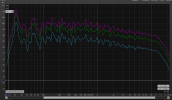Reference:

I think this graph is a bit misleading / easy to misunderstand. At a glance it looks like the untrained listeners want +12db in the bass, but that's not really the case. The flat area at 1-10khz for the untrained listeners is actually at +2/+3dB, so the total rise is closer to 9-10dB.
Similarly, the trained listeners appear to only want 4-5dB rise, but that's not the case either, as that graph continues down below 0dB.
So:
For untrained listeners, the difference between 50hz and 10khz is around 9-10dB
For trained listeners, the difference between 50hz and 10khz is 7-8dB
I've retraced them (roughly) here in two separate graphs normalizing them to the 1-2khz area instead, making it easier to see that they're actually not that different in total rise / how much bass each group wants. The big difference is that trained listeners prefers a more gradual / even roll-off, and more energy in a wider range of the upper bass / lower mid area. It is also worth noting/remembering that this was after all a relatively small study (11 participants alltogether).


I think this graph is a bit misleading / easy to misunderstand. At a glance it looks like the untrained listeners want +12db in the bass, but that's not really the case. The flat area at 1-10khz for the untrained listeners is actually at +2/+3dB, so the total rise is closer to 9-10dB.
Similarly, the trained listeners appear to only want 4-5dB rise, but that's not the case either, as that graph continues down below 0dB.
So:
For untrained listeners, the difference between 50hz and 10khz is around 9-10dB
For trained listeners, the difference between 50hz and 10khz is 7-8dB
I've retraced them (roughly) here in two separate graphs normalizing them to the 1-2khz area instead, making it easier to see that they're actually not that different in total rise / how much bass each group wants. The big difference is that trained listeners prefers a more gradual / even roll-off, and more energy in a wider range of the upper bass / lower mid area. It is also worth noting/remembering that this was after all a relatively small study (11 participants alltogether).
Last edited:

